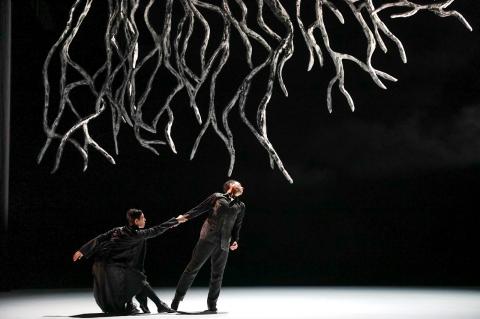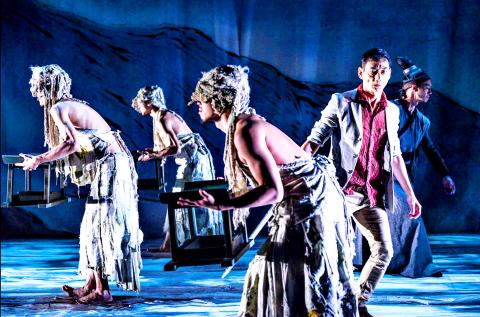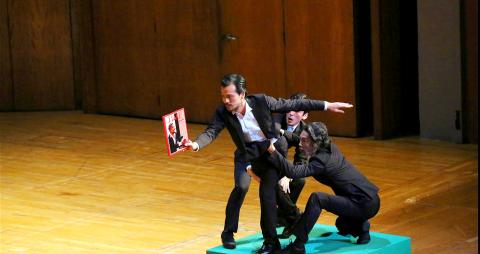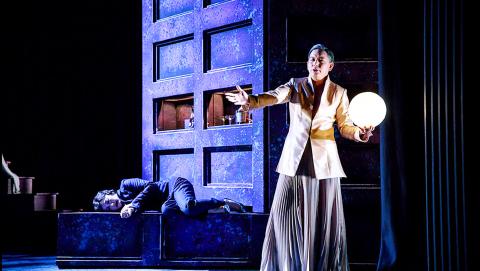For the eighth annual Hong Kong Week, the Hong Kong-Taiwan Cultural Co-operation Committee used “From Text to Stage” as its theme in selecting works by the territory’s top dance, theater and music companies to present in Taipei.
While “week” is part of the title, the program actually runs slightly longer, from tomorrow through Sept. 29, plus an extra performance by the Hong Kong Sinfonetta at the National Taichung Theater on Oct. 8.
One unique feature of this year’s festival is that a number of Taiwanese artists are among the performers.

Photo Courtesy of City Contemporary Dance Company
Hong Kong Week opens tomorrow with a hotly awaited performance by City Contemporary Dance Company (城市當代舞蹈團, CCDC) of the double bill that launched its 40th anniversary program in April, Helen Lai’s (黎海寧) Winterreise and The Rite of Spring (冬之旅.春之祭).
It is doubtful that anyone at CCDC or the organizing committee knew just how pertinent the program would be.
Lai’s 1992 classic The Rite of Spring was inspired by Vaslav Nijinsky’s 1913 Le Sacre du Printemps, using the same 33-minute score by Russian composer Igor Stravinsky, but her piece reflects the chaos of Hong Kong in the 1990s. It centers on the struggle for power between a choreographer, performers and audiences.

Photo Courtesy of Fung Wai-sun
A year ago, Lai met with Taiwanese dancer/choreographer Chou Shu-yi (周書毅) to discuss collaborating on a revival of the work, in which he would join the CCDC dancers and other guest artists.
Lai told a news conference in Taipei last month that she was both surprised and worried by the parallels between her 27-year-old work and the current situation in Hong Kong, having taken part in several of this summer’s anti-extradition bill protests.
Chou said Lai’s Rite of Spring demonstrates how unrest in the world “has been repeated and has never died down.”

Photo Courtesy of the Hong Kong Sinfonietta
Lai's new work, Winterreise, is set to 10 of the songs from Franz Schubert’s 1828 song cycle of the same name
Winterreise depicts the loneliness of travelers on wintry roads and Lai said the double bill presents “two distinct styles of dancing and two unique stories.”
On Friday night, the Tang Shu-wing Theatre Studio (鄧樹榮戲劇工作室) opens a two-show run of renowned theater director Tang Shu-wing’s (鄧樹榮) The Tragedy of Macbeth (馬克白的悲劇) at the Taipei City Shuiyuan (Wellspring) Theater (台北市水源劇場).

Photo courtesy of RhapsoArts Management
Tang has adapted William Shakespeare’s classic to tell the story of a modern couple who assume the roles of Macbeth and Lady Macbeth as they commit a series of murders in their bid for the throne.
The production was originally commissioned by Shakespeare’s Globe of London and the Hong Kong Arts Festival.
The following weekend offers a choice of two shows: Ghost Love, a chamber opera at the National Taiwan University of Arts Performance Hall (國立臺灣藝術大學臺藝表演廳) on Sept. 27 and 28, or the Hong Kong Sinfonietta’s (香港小交響樂團) A Soldier’s Story 5.0 — The Devil Returns (小城大兵的故事—魔鬼回歸) at the National Concert Hall on Sept. 27.
Ghost Love, by composer Chan Hing-yan (陳慶恩) to a libretto by Yi Heng (意珩) is based on Xu Xu’s (徐訏) 1939 novella by the same name. Japanese director Tomo Sugao helmed the piece, with Lio Kuok-man (廖國敏) conducting.
Set in 1945, it tells the story of a man who is alone in Hong Kong after fleeing Shanghai and who meets the ghost of woman and wants to know more about her. It will be performed in Mandarin with Chinese and English surtitles.
A Soldier’s Story 5.0 — The Devil Returns is described by the organizers as “a dialogue between music, text and dance,” as it features three very different works.
The first is Autumn Rhythm, by composer Daniel Lo (盧定彰), which was commissioned by the Sinfonietta and inspired by Jackson Pollock’s art.
The second is Mozart’s “Violin Concerto No. 5 in A,” which will feature Taiwanese violinist Tseng Yu-chien (曾宇謙).
The third is an updating of choregrapher Yuri Ng’s (伍宇烈) 2005 collaboration with the Sinfonetta, The Devil’s Tale, set to Stravinsky’s The Soldier’s Tale. Taiwanese dancer/choreographer Chen Wu-kang (陳武康) is one of the four performers from around Asia in the cast.
The Sinfonetta and cast will return to Taiwan to perform the show in Taichung on Oct. 8.
The final two parts of Hong Kong Week, both at Huashan 1914 Creative Park, are free: In The Shifting Scenes — Mao Chun-fai on Text, Stage and Performance (談戲風生—毛俊輝說文本、舞台、表演) and the HK Illustration X Original Design Brands Exhibition (香港插畫 X 創意設計品牌展).
From 2pm to 4pm on Sept. 29, famed theater director and producer Mao Chun-fai (毛俊輝) will discuss his works and insights on creation honed over three decades, alongside a panel of three artists he has collaborated with: Taiwanese poet and author Lo Chih-cheng (羅智成), actress Alice Lau (劉雅麗) and Cantonese opera actress Amy Wu (胡美儀).
Admission is free, but you need to register via Acupass (www.accupass.com/event/1907080918251134297990).
There will also be an exhibition of photographs and other materials from Mao’s career, which will be open from 4pm to 6pm on Sept. 28, from 10am to 6pm on Sept. 29 and from 10am to 1pm on Sept. 30.
The design exhibition, which opens tomorrow and runs through Sept. 29, is centered on the theme “IDNA” — “Illustration,” “Design,” “New Form” and “Art” — and aims to showcase the work of Hong Kong illustrators and IP designers in two sections.
The first is new works especially created by 11 illustrators especially for the show, all based on the same text. The second part is a display of illustrations, toys, animation, comics and licensed design works and related products and augmented reality games.
The Hong Kong Week Web site has more information on the shows and casts and links to ticketing, in English and Chinese, at www.hongkongweek-taiwan.hk.
This story has been corrected since it was first published to show that Chou Shu-yi is performing in "Rite of Spring," not "Winterreise."

The canonical shot of an East Asian city is a night skyline studded with towering apartment and office buildings, bright with neon and plastic signage, a landscape of energy and modernity. Another classic image is the same city seen from above, in which identical apartment towers march across the city, spilling out over nearby geography, like stylized soldiers colonizing new territory in a board game. Densely populated dynamic conurbations of money, technological innovation and convenience, it is hard to see the cities of East Asia as what they truly are: necropolises. Why is this? The East Asian development model, with

June 16 to June 22 The following flyer appeared on the streets of Hsinchu on June 12, 1895: “Taipei has already fallen to the Japanese barbarians, who have brought great misery to our land and people. We heard that the Japanese occupiers will tax our gardens, our houses, our bodies, and even our chickens, dogs, cows and pigs. They wear their hair wild, carve their teeth, tattoo their foreheads, wear strange clothes and speak a strange language. How can we be ruled by such people?” Posted by civilian militia leader Wu Tang-hsing (吳湯興), it was a call to arms to retake

This is a deeply unsettling period in Taiwan. Uncertainties are everywhere while everyone waits for a small army of other shoes to drop on nearly every front. During challenging times, interesting political changes can happen, yet all three major political parties are beset with scandals, strife and self-inflicted wounds. As the ruling party, the Democratic Progressive Party (DPP) is held accountable for not only the challenges to the party, but also the nation. Taiwan is geopolitically and economically under threat. Domestically, the administration is under siege by the opposition-controlled legislature and growing discontent with what opponents characterize as arrogant, autocratic

When Lisa, 20, laces into her ultra-high heels for her shift at a strip club in Ukraine’s Kharkiv, she knows that aside from dancing, she will have to comfort traumatized soldiers. Since Russia’s 2022 invasion, exhausted troops are the main clientele of the Flash Dancers club in the center of the northeastern city, just 20 kilometers from Russian forces. For some customers, it provides an “escape” from the war, said Valerya Zavatska — a 25-year-old law graduate who runs the club with her mother, an ex-dancer. But many are not there just for the show. They “want to talk about what hurts,” she